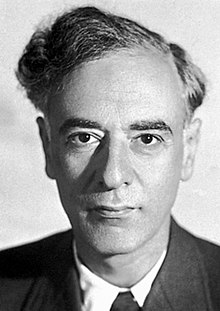
Back Lef Landau Afrikaans ليف لانداو Arabic ليف لانداو ARZ লে'ভ লাণ্ডাউ Assamese Lev Landáu AST Lev Landau Azerbaijani لو لانداو AZB Ландау Лев Давидович Bashkir Леў Давідавіч Ландау Byelorussian Леў Ландаў BE-X-OLD
Lev Davidovich Landau (Russian: Лев Дави́дович Ланда́у; 22 January 1908 – 1 April 1968) was a Soviet physicist who made fundamental contributions to many areas of theoretical physics.[1][2][3] He was considered as one of the last scientists who were universally well-versed and made seminal contributions to all branches of physics.[4] He is credited with laying the foundations of twentieth century condensed matter physics,[5] and is also considered arguably the greatest Soviet theoretical physicist.[6]
His accomplishments include the independent co-discovery of the density matrix method[7][8] in quantum mechanics (alongside John von Neumann), the quantum mechanical theory of diamagnetism, the theory of superfluidity, the theory of second-order phase transitions, invention of order parameter technique,[9] the Ginzburg–Landau theory of superconductivity, the theory of Fermi liquids, the explanation of Landau damping in plasma physics, the Landau pole in quantum electrodynamics, the two-component theory of neutrinos, and Landau's equations for S-matrix singularities.[10] He received the 1962 Nobel Prize in Physics for his development of a mathematical theory of superfluidity that accounts for the properties of liquid helium II at a temperature below 2.17 K (−270.98 °C).[11]
- ^ McCauley, Martin (1997). Who's Who in Russia Since 1900. Routledge. p. 128.
Landau, Lev Davydovich (1908-68), a brilliant Soviet theoretical physicist, who was born into a Jewish family in Baku and graduated from Leningrad State University in 1927.
- ^ Zubok, Vladislav (2012). "Soviet Intellectuals after Stalin's Death and Their Visions of the Cold War's End". In Bozo, Frédéric; Rey, Marie-Pierre; Rother, Bernd; Ludlow, N. Piers (eds.). Visions of the End of the Cold War in Europe, 1945-1990. Berghahn Books. p. 78.
- ^ Cite error: The named reference
ScientificAmerican1997was invoked but never defined (see the help page). - ^ Smilga, Andrei V. (2017). Digestible Quantum Field Theory. Cham: Springer. p. 250. ISBN 978-3-319-59922-9.
- ^ Gorelik, Gennady (1997). "The Top-Secret Life of Lev Landau". Scientific American. 277 (2): 72–77. Bibcode:1997SciAm.277b..72G. doi:10.1038/scientificamerican0897-72. ISSN 0036-8733. JSTOR 24995874.
- ^ Ryndina, Ella (1 February 2004). "Family Lines Sketched in the Portrait of Lev Landau". Physics Today. 57 (2): 53–59. Bibcode:2004PhT....57b..53R. doi:10.1063/1.1688070. ISSN 0031-9228.
- ^ Lev Landau (1927). "Das Dämpfungsproblem in der Wellenmechanik (The Damping Problem in Wave Mechanics)". Zeitschrift für Physik. 45 (5–6): 430–441. Bibcode:1927ZPhy...45..430L. doi:10.1007/bf01343064. S2CID 125732617. English translation reprinted in: D. Ter Haar, ed. (1965). Collected papers of L.D. Landau. Oxford: Pergamon Press.
- ^ Schlüter, Michael; Lu Jeu Sham (1982). "Density functional theory". Physics Today. 35 (2): 36. Bibcode:1982PhT....35b..36S. doi:10.1063/1.2914933. S2CID 126232754. Archived from the original on 15 April 2013.
- ^ Fisher, Michael E. (1 April 1998). "Renormalization group theory: Its basis and formulation in statistical physics". Reviews of Modern Physics. 70 (2): 653–681. Bibcode:1998RvMP...70..653F. doi:10.1103/RevModPhys.70.653.
- ^ Shifman, M., ed. (2013). Under the Spell of Landau: When Theoretical Physics was Shaping Destinies. World Scientific. doi:10.1142/8641. ISBN 978-981-4436-56-4.
- ^ Kapitza, P. L.; Lifshitz, E. M. (1969). "Lev Davydovitch Landau 1908–1968". Biographical Memoirs of Fellows of the Royal Society. 15: 140–158. doi:10.1098/rsbm.1969.0007.
